In Louisville, Relief and Regret After Ex-Officer’s Conviction in Breonna Taylor Case

© Amira Karaoud/Reuters

© Amira Karaoud/Reuters

© Nicole Craine for The New York Times

© Timothy D. Easley/Associated Press

© Tyler Hicks/The New York Times
In the first of these two articles looking at the reading of balconies in paintings, I looked at views of balconies from the outside; today we get to join the rich and famous and look out and down on the world below. Before cheap and easy travel became available in the late nineteenth century, standing on a balcony was probably one of the more elevating experiences for most of the population.

There has been speculation as to whether Carpaccio’s Two Venetian Ladies from about 1490 were bored upper class wives, or courtesans in between gigs, although opinion currently favours their nobility. They sit amid a menagerie of peacock, doves and two dogs, staring into the blank distance.
Views from the balcony came of age in the early nineteenth century, with the arrival of paintings of figures standing in front of windows. These developed most obviously in German painting, in Caspar David Friedrich’s Woman at the Window of 1822, further elaborated two years later by his friend and follower Carl Gustav Carus.

First came Carus’ Friedrichian Woman on the Balcony from 1824. High above the rolling wooded countryside of central Germany, a young woman dressed in black sits contemplating the view and facing away from the viewer. The artist tells us where he painted this view from, and adds some foreground detail to help mystify the viewer.
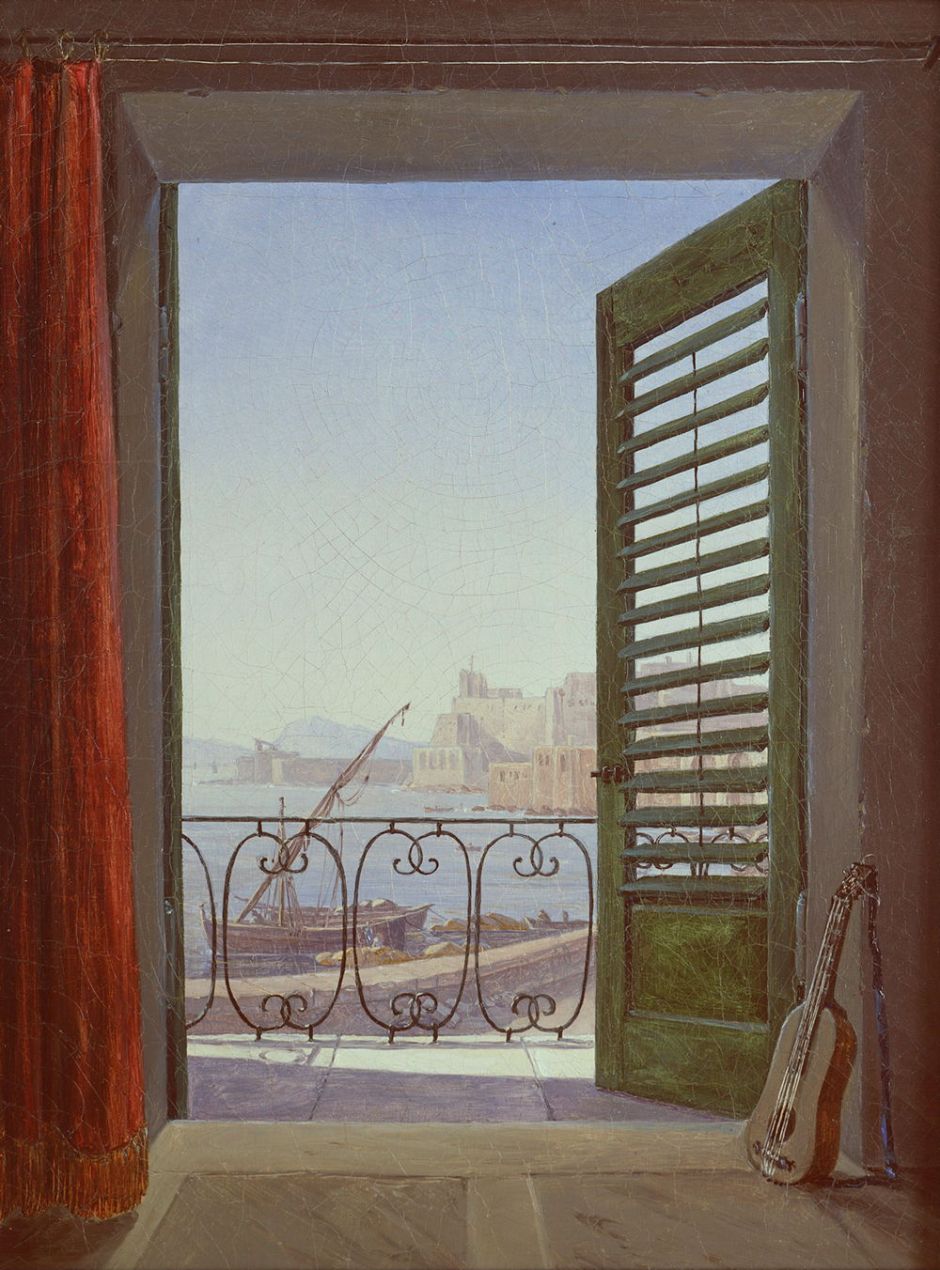
When Carus visited Naples in about 1829-30, he stayed close to Castel dell’Ovo, and framed a view in his Balcony Room with a View of the Bay of Naples (via Santa Lucia and the Castel dell’Ovo). Instead of a figure, there’s a musical instrument, presumably to reinforce that this is Italy. The interior is mainly used for its framing and repoussoir effect.

After Manet’s The Balcony (1868-69), Berthe Morisot, who modelled for that and was soon to become his sister-in-law, painted her own Woman and Child on a Balcony in 1872. She uses the balcony primarily to combine full-length portraits of the two figures with an aerial landscape of Paris. The pillar and flowerpot at the right steer the eye from immediate foreground in a zigzag past the figures to end in the far distance. On the skyline just to the left of the woman is the dark mass of Notre Dame.
It was Gustave Caillebotte who recast and modernised the precursors of Friedrich and Carus for his painting of his brother René, the Young Man at His Window, in 1875.

Strictly speaking, Caillebotte’s younger brother René isn’t on a balcony here, merely standing in front of a balustraded window in the family apartment on the rue de Miromesnil in Paris. But the artist has here realised the interplay between the rich red upholstery of the interior and the bright exterior with its pale buildings and trees. Between those two worlds is a substantial stone balustrade. Caillebotte gives his figures the mysterious anonymity of facing away from us too.
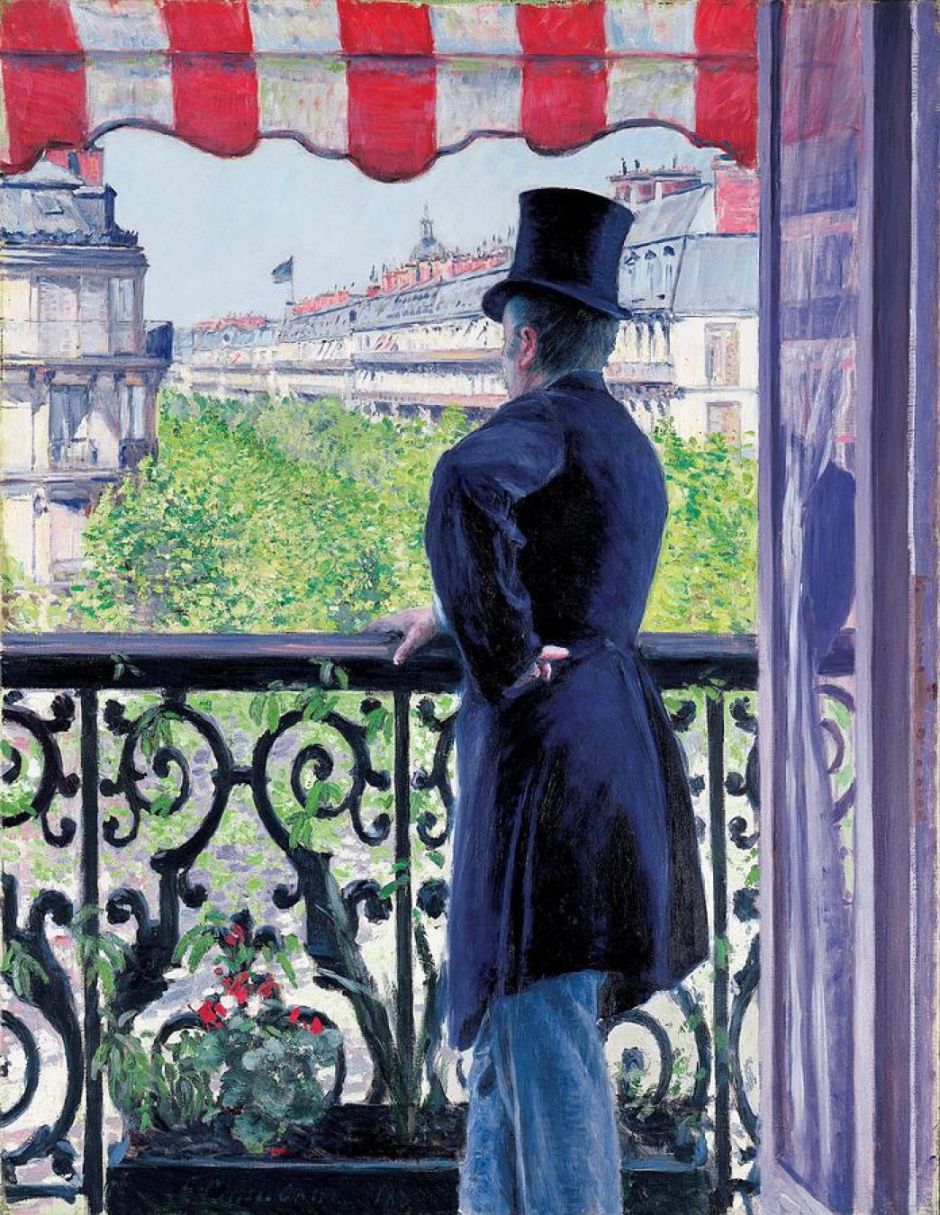
Five years later, Caillebotte embarked on a series of paintings from the balconies of his apartment, of which the best-known is Man on a Balcony, Boulevard Haussmann (1880). The interior has been replaced by intermediate details: a trough of flowers, the ornate iron balustrade, and a colourful awning.

Less well-known are two views looking along the length of A Balcony (1880), above, and another Man on a Balcony (1880), below. Both are revelatory in showing the faces of their figures who are looking across our direction of view, down at the exterior world below. Both are strongly projected to a vanishing point close to one edge of the canvas, and the view above places the head of one of its two figures at that focal point.

Caillebotte went on to paint a couple of tightly-cropped images showing small sections of balustrade with the trees and buildings below. Finally in 1884, he bought Manet’s The Balcony for his private collection.

The Norwegian painter Hans Heyerdahl, who was living in Paris at the time, responded with his close-cropped At the Window in 1881 (above), and the following year his compatriot Christian Krohg painted his Portrait of the Swedish Painter Karl Nordström (below) using the same artistic device. Krohg didn’t paint this in Paris, but as he neared the end of his time in France in the artists’ colony of Grez-sur-Loing, in the Spring of 1882.
Heyerdahl engages deeply in the interplay between the woman’s interior world, with a half-open book on her lap, and her distant gaze towards the bright exterior.

Prior to this development of the themes of Friedrich and Carus, balconies had often played minor roles in portrait paintings. Maybe the sitter leaned on a section of balustrade, or a flowerpot cascaded its blooms from a pillar. In the late nineteenth century, balconies acquired greater prominence in a wide range of portraits and figurative paintings. Some of that was undoubtedly the result of their increasing availability: with the growth of cities, balconies became popular features of upmarket city apartments, particularly those in Paris.

This portrait of Maximilien Luce’s then unmarried partner and model Ambroisine ‘Simone’ Bouin, Madame Luce on the Balcony from 1893, is an example with objects from its interior set out in the outside sunshine.
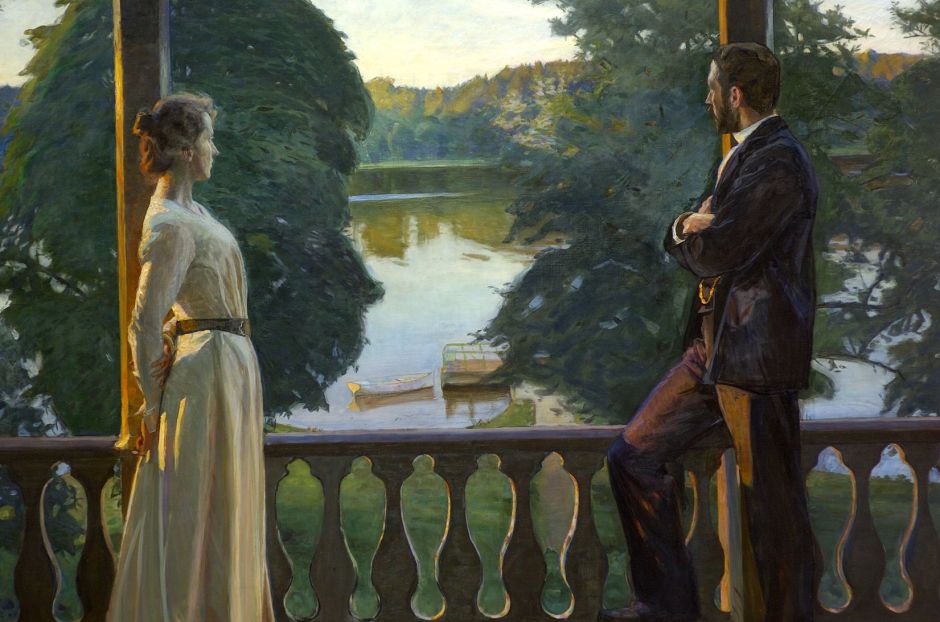
Richard Bergh’s Nordic Summer’s Evening (1899-1900) features two distinguished models, Prince Eugen, Duke of Närke, and the singer Karin Pyk, who were both close friends of the artist. In fact, it’s a wonderful composite: the pillars shown were borrowed from the floor below, where they supported this balcony, and Pyk was actually painted when she was in Assisi in Italy. Their figures look not at one another, but their gazes cross paths as they stare at the still parkland beyond, lit by the low sun.

We can only imagine the ‘cheating’ that Isaak Brodsky must have contrived to paint this marvellous Self-portrait with Daughter in 1911. Here, the balcony is an integral part of an aerial precinct in the town; there is no sight of ground level. Brodsky’s world exists a couple of stories above.

Lovis Corinth painted this Balcony Scene in Bordighera in 1912 early during his convalescence in the Midi after his stroke the previous year.

The scene in Nikolay Bogdanov-Belsky’s Lady on a Balcony appears more relaxed. His sitter, I.A. Yusupova, looks to be enjoying the fine summer weather in Koreiz, not far from Yalta, on the northern coast of the Black Sea. At about this time, the Balkans had been plunged into crisis following the assassination of Archduke Franz Ferdinand, and by the end of July the Great War had begun. During its closing stages, the Crimean Peninsula was swept up in the Russian Civil War, and changed hands every few months, with tens of thousands being massacred during the chaos.
The last artist whose paintings I show here had a lasting fascination for painting views through windows, extending to the balconies he had added to his homes: Pierre Bonnard.

In La Fenêtre (The Window) from 1925, Bonnard frames the view from his villa in Le Cannet looking inland, and includes part of the all-important balcony.

One of Bonnard’s fullest views of a balcony comes in The French Windows with Dog from 1927, where our gaze is led from its interior, out through the French windows, over the decking and wooden balustrade, to the palms and town of Le Cannet beyond.
The view from the balcony is a journey through life.
The climax of the year in arable farming is the harvest, when the sustained labour of the previous year pays off. For the farmer, this is the return on that investment, and for the labourers it’s when they hope to get paid their bonus. It’s the one time of the year when everyone turns to and works from before dawn until well after dusk in a united effort to harvest the ripe crop, before the weather breaks and it might be ruined.
The harvest depends on the crop being grown; as cereals, particularly wheat, were the most important across much of Europe, I’ll here concentrate on the processes required to turn them from ripe plants to grain ready for the miller to grind into flour. This article looks at the first step in that, cutting the crop, bundling it into sheaves and stacking those in stooks.
Current accounts of the grain harvest distinguish several tools used to cut the crop:
Some claim that reaping using a handheld sickle or hook was used for wheat and rye, but that barley and oats were more usually mown with a larger scythe. Although that doesn’t appear to be accurate, it’s clear that the use of scythes was considerably more efficient. While it took about 4 worker-days to cut an acre of grain using a sickle or hook, using a scythe typically took only 2 worker-days per acre. Scythes appear to have been used almost exclusively by men, while sickles and hooks were used by both men and women.
The tool used also determined the length of straw stalk cut with the head of grain, thus the height of the stubble left on the field. Sickles and hooks were often used when less straw was required, leaving high stubble that might be mown with a scythe later. Low reaping or bagging, or mowing with a scythe, created longer straw that was suitable for thatching.
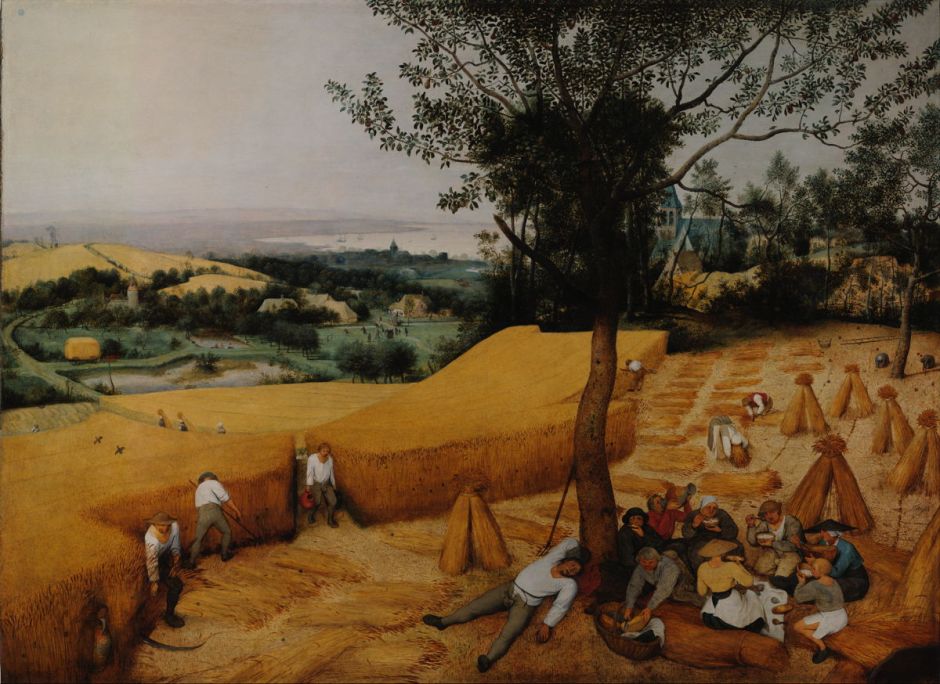
Pieter Brueghel the Elder’s Harvesters from 1565 shows men cutting a crop of wheat close to the base of the stem using scythes, leaving short stubble. This ensures the best yield of straw as well as grain.
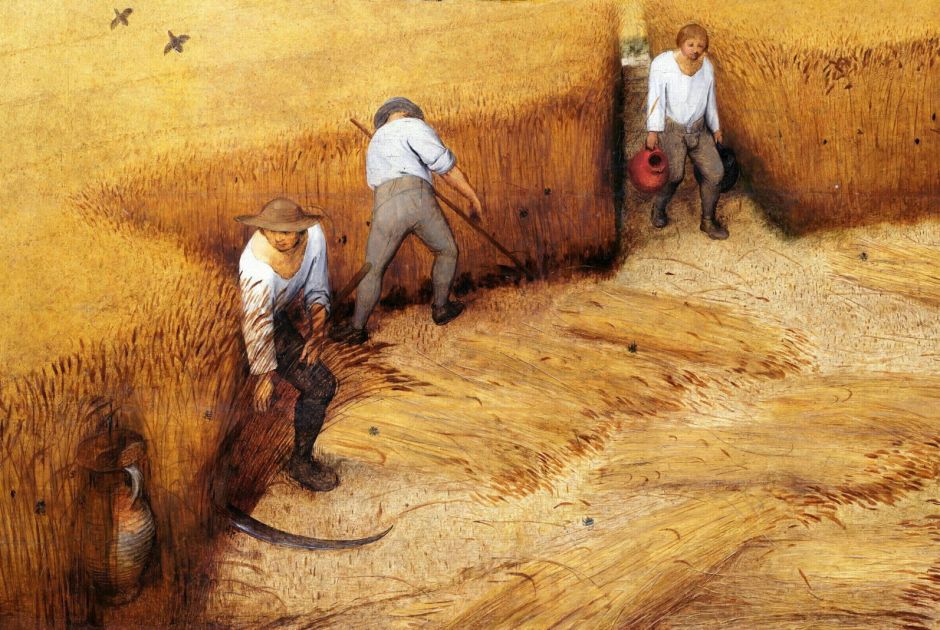
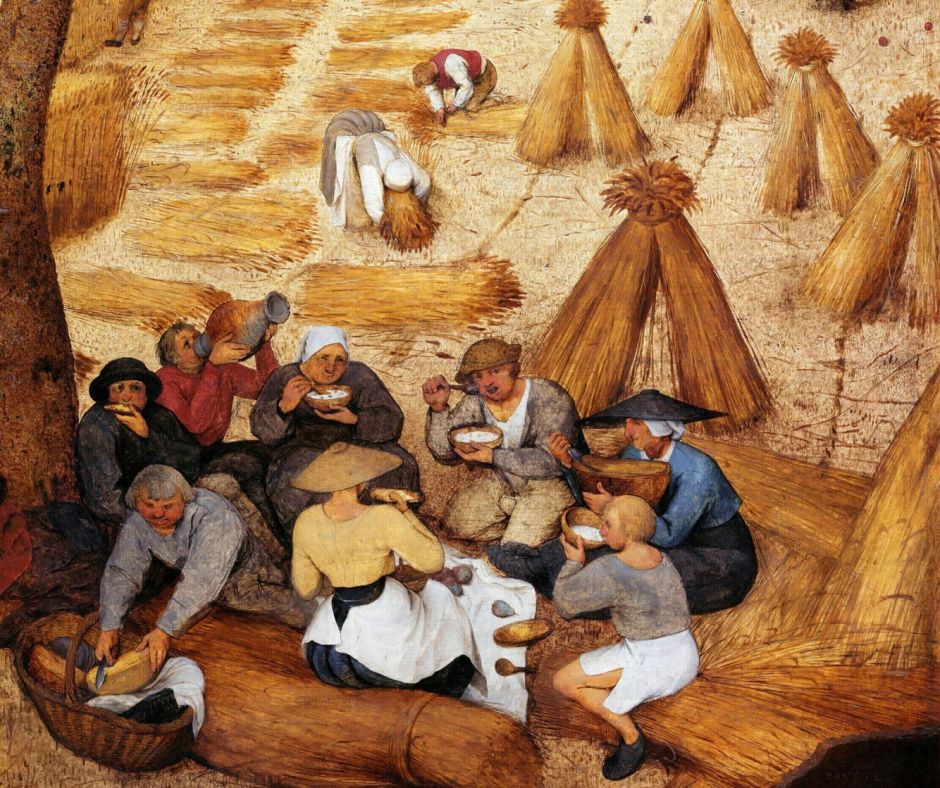
Behind these workers eating bread baked from flour ground from cereal grown in the same fields, cut cereal is tied first into sheaves before they’re gathered into stooks.

Anne Vallayer-Coster’s Garden Still Life, with Implements, Vegetables, Dead Game, and a Bust of Ceres (The Attributes of Hunting and Gardening) from 1774 shows at its left edge a long-handled scythe, and at the right a sickle or reaping hook. Scythes were also used extensively for mowing hay and weeds.

In about 1833, when Samuel Palmer painted his wonderful Harvest Moon near Shoreham in Kent, harvesting went on well into the night. These are mostly women wielding sickles or reaping hooks to cut a small field of wheat. The cut stalks are then formed into stooks and piled onto the oxcart for transport to nearby farm buildings.

Palmer’s mentor John Linnell painted The Harvest Cradle twenty-five years later, in 1859. The harvesters have their backs to the viewer, but appear to be using scythes to cut this wheat crop. Bundles of cut grain are tied as sheaves, then assembled into stooks in the foreground.

Jean-François Millet’s Ceres (The Summer) from about 1864-65 is unusual in that the goddess is shown holding a sickle with a serrated edge, and is surrounded by sheaves of wheat.

Léon Augustin Lhermitte’s famous Harvesters’ Pay from 1882 shows four harvesters, bearing their heavy-duty scythes, as they await payment by the farmer’s factor, who holds a bag of coins for the purpose. In the right foreground are two tied sheaves of cut wheat, with a lightweight sickle resting on them.

During the nineteenth century some attached cradles to the blade, to make sheaving easier. This is shown in Laurits Andersen Ring’s painting of Harvest. The crop being cut here may well be rye rather than wheat. The artist got his brother to model for this “monument to the Danish peasant” during the summer of 1885, while working on his farm near Fakse, on Sjælland (Zealand), Denmark.

Volodymyr Orlovsky’s Harvest in Ukraine from 1880 shows wheat being cut on the steppe, with the worker in the foreground carrying a scythe, but those cutting in the middle distance bent over as if using hooks instead.

The young woman in Mykola Pymonenko’s portrait of a Reaper from 1889 has been cutting what could be rye or wheat using a heavier bagging hook, although she isn’t using the hooked stick normally required for the technique, so could be using it as a regular reaping hook. The woman behind her demonstrates that these harvesters are cutting low to keep a good length of straw on the harvested crop.

Anna Ancher, wife of Danish painter Michael Ancher, caught this procession of Harvesters on their way to their work in 1905, near her home in Skagen on the north tip of Jylland (Jutland). The leader carries his scythe high as they pass through ripe wheat.
Finally, conventional corn stooks were by no means universal across Europe.

By tradition on Norwegian farms, cut corn (cereal) wasn’t left to dry in low stooks, as in most of Europe and America, but built onto poles. In a series of paintings and prints, Nikolai Astrup developed these Corn Stooks (1920) into ghostly armies standing on parade in the fields, the rugged hills behind only enhancing the feeling of strangeness.
These paintings suggest that, between 1550 and 1890, wheat was generally cut using scythes when suitable men were available. Otherwise, it would be cut using a hook, most likely for reaping rather than bagging. Wheat was normally cut low to preserve the stalk as straw suitable for thatching, then tied into sheaves before being stacked into stooks.
That left the fields ready for gleaning.
In the first of these two articles, I showed paintings illustrating school life from the early seventeenth century to the middle of the nineteenth, a period of more than two centuries when few artists painted the inside of the classroom. This changed from 1850, although the theme still failed to attract the best-known painters.

Albert Anker, father of Swiss painting and known for his large output of ‘genre scenes’, probably painted more classrooms than any other. He painted The Village School in 1848 nearly half a century afterwards, in 1896, presumably from his own recollection of his final year at school in Neuchâtel. Compared to earlier paintings, this classroom is packed, relatively orderly, and well-equipped with benches and desks, even though the children are shabbily dressed, indicating their poverty.

Anker’s earlier painting of The School Exam from 1862 shows a more contemporary scene. It’s not clear whether the pupils are undergoing examination, or the school is. Three of them seen standing out at the front are so poor that they cannot afford shoes at all, but effort is at last being put into their education.

Winslow Homer is perhaps the most famous painter to have made more than one work showing The Country School, believed to be of a country schoolroom in the Catskills, New England. This painting, dated 1871, is the first of a series of three or more showing the same largely empty classroom, with its impossibly wide age range. Two of the boys reading to the teacher are too poor for shoes, although the girls on the right look much better-dressed.
Following the collapse of the Second Empire during the Franco-Prussian War of 1870-71, the Third Republic targeted education for special development. Schools in France had earlier been largely run by the Catholic Church, but from 1833 communes had been required to provide schools for boys but not girls. The anti-clerical Minister for Public Instruction, Jules Ferry, introduced laws in 1881 to establish free education throughout the country, even for girls, and progressively replaced existing Catholic schools with the modern Republican School through the 1880s.

François Bonvin’s The Scholar of 1874 is one of a few paintings showing individual pupils in the classroom. This boy has been granted the privilege of his own desk, at the front of the class, and is working on after the end of the school day. The teacher’s hat and coat are draped over his desk, ready for when this pupil completes his extra work.

Jean-Baptiste Jules Trayer’s wonderful watercolour of A Breton Infants School from 1882 predates any celebration of the Republican policy: the crucifix high on the wall at the right shows that this is one of the older Catholic schools. It shows a teacher helping one of her students with writing, in a class entirely wearing traditional Breton costume. There’s clearly room for improvement, though, as one girl is sleeping on her book, doubtless exhausted from her early morning work on the family farm.

Rising standards of schooling were also reaching out to some of the more remote communities in Nordic countries. Oscar Björck’s painting of Madam Henriksen’s School for Girls in Skagen from 1884 shows a tiny and personal class in this small, isolated community at the northern tip of Jylland (Jutland), home to a major artists’ colony and birthplace of Danish Impressionism.
Then, in the mid 1880s, something remarkable happens to paintings of the schoolroom in France: they become strikingly photographic in their reality, with the advent of Naturalism.
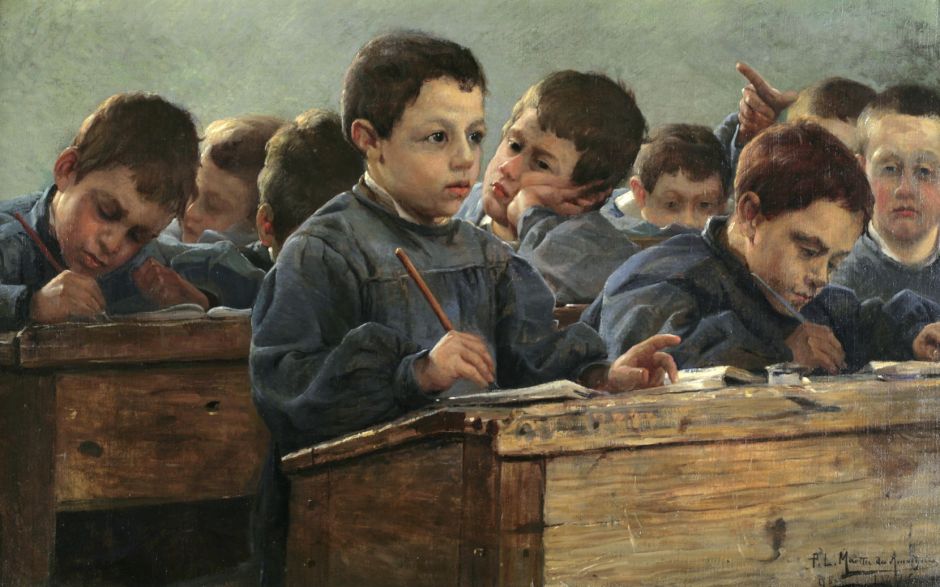
Within two years of the early death of Jules Bastien-Lepage, Paul Louis Martin des Amoignes’ In the Classroom (1886) looks as if it may have been painted from photographs. One boy, staring intently at the teacher in front of the class, is caught crisply, pencil poised in his hand. Beyond him the crowd of heads becomes more blurred.

Jean Geoffroy’s Primary School Class from 1889 doesn’t give us the same depth of field effect, but shows one of the Republic’s new lay teachers working diligently in the classroom with her pupils. They’re still a bit of a shower, with the younger ones at the back working on traditional slates, but this is the public face of the modern Republican School.

In Geoffroy’s In School from about 1900, another lay teacher in a modern Republican infants class is caring for the French men and women of the future.
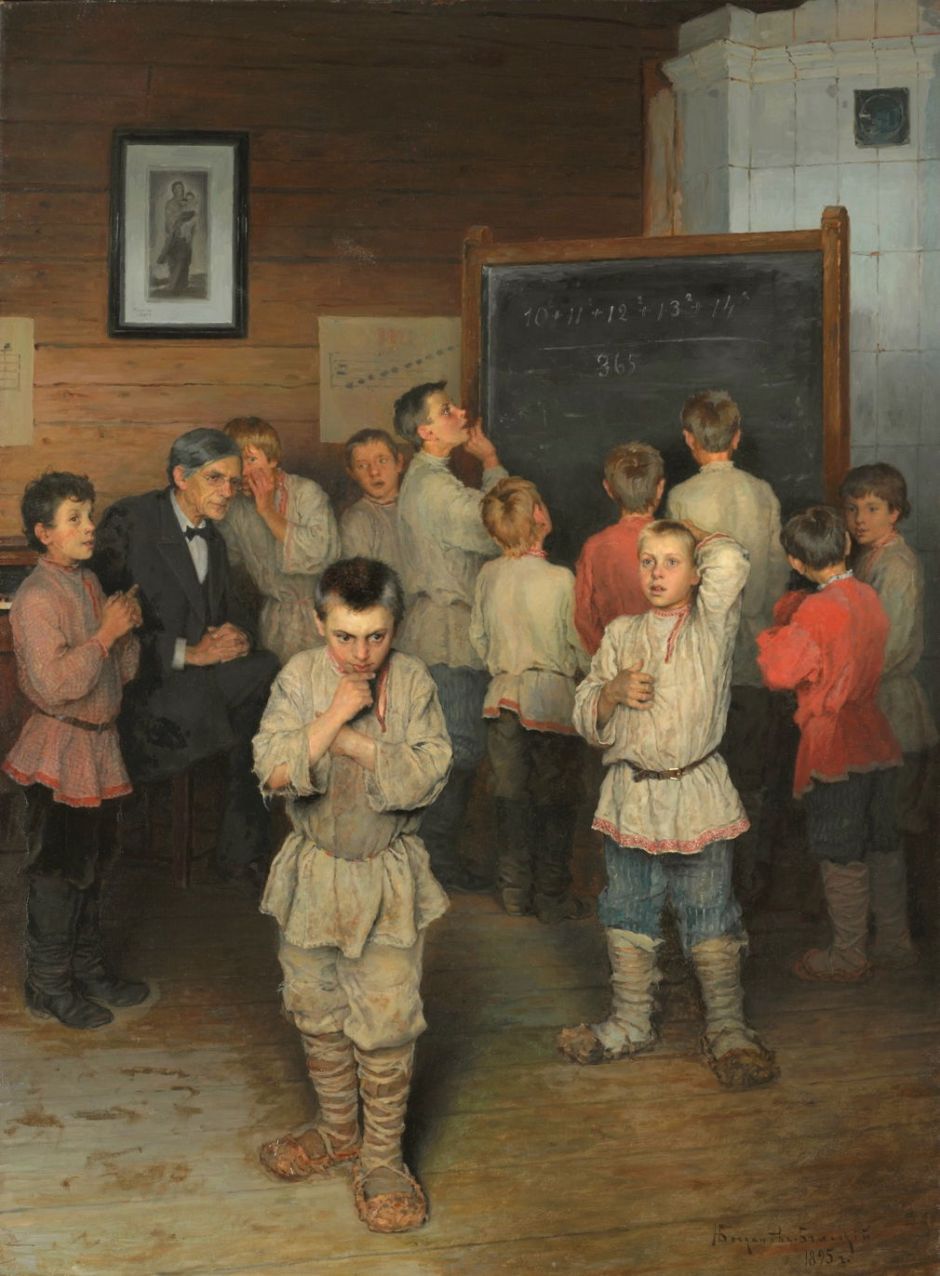
Of course France wasn’t the only country to be improving its educational system at this time. Nikolay Bogdanov-Belsky’s Mental Arithmetic. In Public School of S. A. Rachinsky from 1895 shows a class of poor students in the village of Tatev in Smolensk province, at the western edge of the Russian Empire in central eastern Europe. They were fortunate enough to have a pioneering educator as their local teacher.
Sergey Rachinsky had been a professor of botany in Moscow until 1867, when he abandoned academic life to run the village school in Tatev. The elderly professor is seen with his students working on a challenging mental arithmetic problem. The teacher died in 1902.

My final painting, by the Ukrainian artist Max Silbert, shows a Singing Lesson in a School in Holland in 1907, and is a fascinating chance discovery. Although its realism isn’t as detailed or photographic as the French paintings from the 1880s above, it shows a similar photographic depth of field effect. The pupils closest to the artist are shown in sharp focus, and those in the further distance are markedly blurred. It’s impossible to tell whether this results from Silbert painting this work from photographs with the same blurring, or it was a deliberate effect introduced by the artist to give it a photographic look.
Camels have continued to feature in paintings showing more recent times, from events at the end of the eighteenth century, when Napoleon was in Egypt.

Jean-Léon Gérôme made several paintings showing Napoleon in Egypt, including this highly detailed and intricate version of General Bonaparte and his Staff in Egypt from 1867. The French Campaign in Egypt and Syria had been in 1798-1801, so this was still relatively recent history, even when viewed from the distance of the final years of the Second Empire.
Dromedaries were introduced to Australia in the nineteenth century to carry people and loads through its arid regions. They came to prominence in the ill-fated Burke and Wills Expedition of 1860 to cross the continent of Australia from south (Melbourne) to north in the Gulf of Carpentaria.

Nicholas Chevalier painted this Memorandum of the Start of the Exploring Expedition to mark the occasion in 1860. The team left Royal Park, Melbourne on the afternoon of 20 August 1860 with nineteen men and about twenty tonnes of equipment and stores. Included were more than twenty-four camels, horses and wagons. Only one of the team survived to complete the crossing, and seven died, including both Burke and Wills.

David Roberts’ painting of the Isle of Graia, Gulf of Akabah (1839), shown here as a lithograph, is unusual for showing camels on the beach. We’re used to seeing dogs, horses, donkeys, even cows and sheep, but the ‘ship of the desert’ isn’t a common sight on the beach. The coastline of the Gulf of Aqaba (or Gulf of Eilat) is on the eastern side of the Sinai Peninsula, and before urbanisation, development, and the advent of tourists, had a wild desert beauty, as shown here.
As artists visited North Africa more during the latter half of the nineteenth century, paintings of camels in their natural habitat became more common.
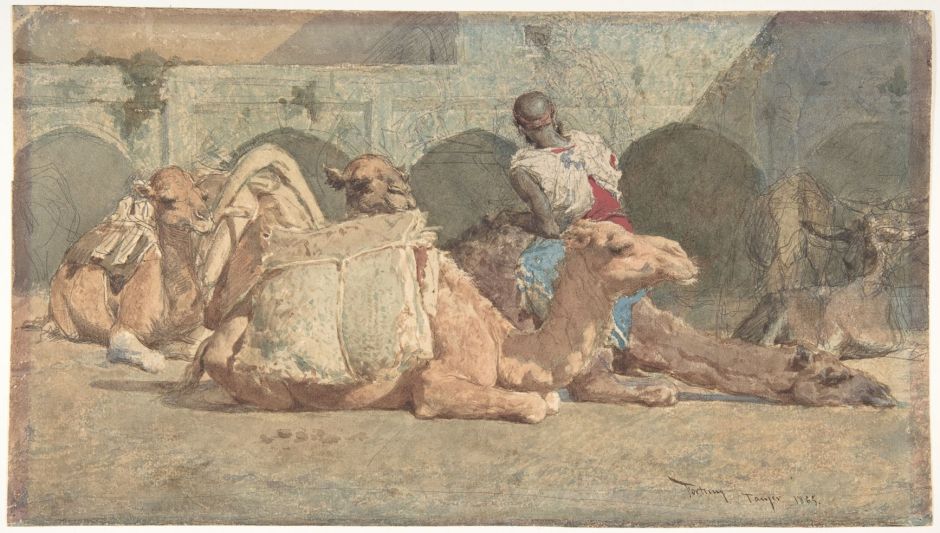
Marià Fortuny’s Camels Reposing, Tangiers (1865) is a watercolour sketch made over a heavily-worked and now visible graphite drawing, showing a group of camels resting near the city of Tangier, not far from Tétouan, in northern Morocco.

Alberto Pasini’s painting of The Caravan of the Shah of Persia from 1867 is a superbly wide view of an extensive royal caravan crossing a desert plain, including a couple of elephants at the right.

When Ivan Aivazovsky visited Tiflis, now Tbilisi, the capital of Georgia in 1868, his superb painting of this cosmopolitan city shows camels on its bustling streets.

Even in 1900-18, when Georgian artist Niko Pirosmani painted this Tatar Camel Driver, they would still have been a common sight in parts of Tbilisi visited by traders from the south, and the artist was clearly familiar with the animal. Tatar traders moved their goods on Bactrian camels as far as Crimea and other parts of southern Ukraine.

Eugen Bracht’s paintings of the Middle East avoid the crowded and bustling towns, preferring the barren desert where just a handful of people travel with their camels In the Arabian Desert (1882).

Bracht’s slightly later view From the Sinai Desert (1884) shows more groups on the move in the relentless heat. The ship of the desert indeed, but never argue with a half-ton camel, even if it’s an entry in a beauty pageant.